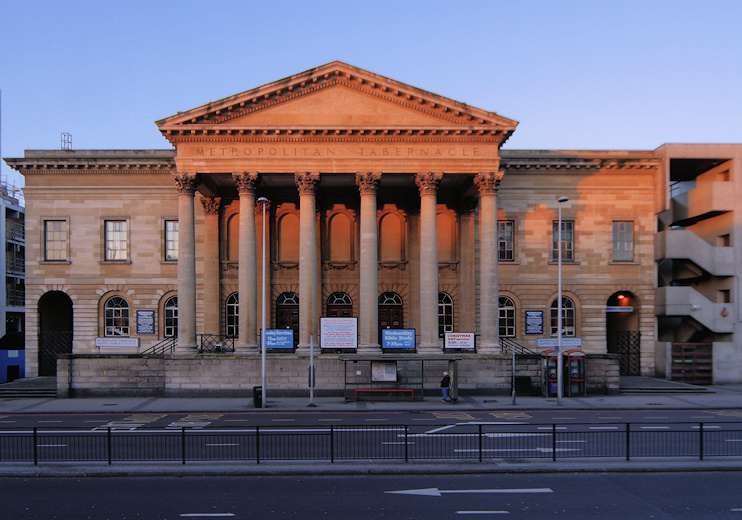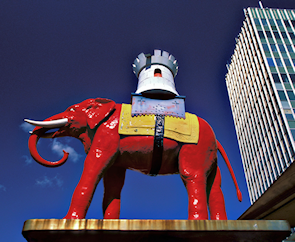Elephant and Castle
Elephant and Castle, Southwark
A busy road junction and its rapidly changing vicinity, situated in (and better known than) Newington, and often simply called ‘the Elephant’

In 1641 John Flaxman set up a blacksmith’s forge on an island site here to take advantage of the passing horse-drawn traffic. Around 1760 the smithy was converted to a tavern that displayed a sign of an elephant and castle. There is almost certainly no truth in the widely held belief that the name is a corruption of Infanta de Castilla (‘Princess of Castile’). The more likely connection is with the old heraldic symbol of an elephant with a castellated tower on its back, which was especially used by the Cutlers’ Company to indicate to the use of ivory in knife handles. The tavern became a coaching halt and thus gave its name to the junction.
This was already a densely built-up area by the time Charles Spurgeon established the Metropolitan Tabernacle in 1861. Shown at dawn in the photograph above, the tabernacle has twice been rebuilt but its original portico survives.
The mainline railway station opened in 1863. In the Victorian era the station was nicknamed ‘the Animal’.† The City and South London Railway arrived nearby in 1890 and the Baker Street and Waterloo Railway added a connection in 1906.

Before the junction was overwhelmed by motor traffic, this was a locality where people came to socialise, shop and be entertained. In 1913 Désiré Pasquet observed in Londres et les Ouvriers de Londres that “South London’s central edifice is a public house – the Elephant and Castle.”
Following its devastation during the Second World War, the area was clumsily redeveloped from the late 1950s with offices, academic buildings, housing estates and the Elephant and Castle shopping centre – a pioneer in its time but notoriously dismal in its latter days and not improved by its garish plastic cladding. With priority given to road traffic, pedestrians were forced into a network of subways.
Notable for its three wind turbines, the Strata skyscraper was completed in 2010 and is the tallest of several residential units to have appeared nearby over the past decade. Elsewhere in the area – and stretching into Walworth – a £1.5 billion regeneration programme had been making elephantine progress – but has accelerated recently.
The most significant new developments are Oakmayne’s Two Fifty One, Lend Lease Corporation’s Elephant Park and Delancey’s town centre redevelopment, which proposes to “replace the existing, poor quality shopping centre with a new town centre which will future-proof Elephant and Castle for the long term and provide numerous benefits for both the local and borough-wide economy”. In addition, Southwark council has opened the Castle leisure centre at St Gabriel Walk, while the Artworks Elephant is a temporary ‘art, work and eat hub’ in repurposed shipping containers on Elephant Road.
The Elephant and Castle shopping centre closed in September 2020, to make way for “a thriving new Zone 1 destination” that will include “a range of high street and independent retailers, enhanced restaurant and leisure opportunities and a new university campus for [the] London College of Communication.”
Shakespeare’s Twelfth Night is set in Illyria but some have taken this to be an idealised England, citing as evidence Antonio and Sebastian’s decision to lodge “in the south suburbs, at the Elephant.”
A shiny electrical substation in the centre of the Elephant and Castle roundabout doubles as a memorial to physicist and chemist Michael Faraday, who was born near here.
Postal districts: SE1 and SE17
Stations: Southern, Thameslink, Bakerloo line terminus, Northern line (zones 1 and 2)
Further reading: Stephen Humphrey, Elephant & Castle: A History, Amberley, 2013
Twitter: Elephant & Castle
Bing bird’s view: Elephant and Castle
